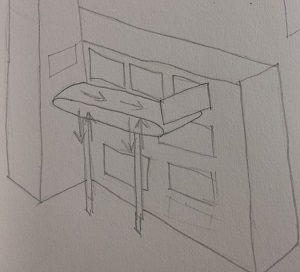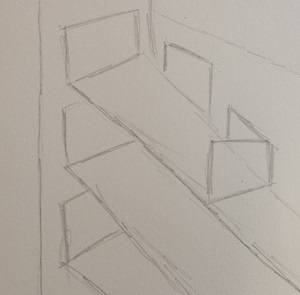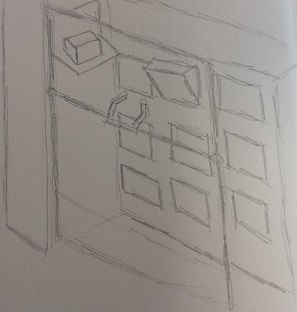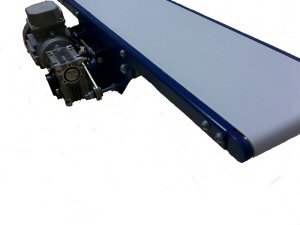Chimney to Cubby: Difference between revisions
No edit summary |
|||
| (51 intermediate revisions by 3 users not shown) | |||
| Line 1: | Line 1: | ||
This is the third phase of the system. After the elevator has brought the package down to the cubby level. | |||
{| border="1" cellpadding="5" cellspacing="0" align="right" width="40%" | {| border="1" cellpadding="5" cellspacing="0" align="right" width="40%" | ||
|+ '''Quick Links''' | |+ '''Quick Links''' | ||
| Line 7: | Line 8: | ||
| [[PRE_Groep1| Home]] | | [[PRE_Groep1| Home]] | ||
| [[Problem Definition]] | | [[Problem Definition]] | ||
| [[ | | [[Opening]] | ||
| | | [[Scenarios]] | ||
|- | |- | ||
| [[Planning & Milestones|Planning and Milestones]] | | [[Planning & Milestones|Planning and Milestones]] | ||
| [[Background Research]] | | [[Background Research]] | ||
| [[Chimney]] | | [[Chimney]] | ||
| & | | [[Rules & Regulations]] | ||
|- | |- | ||
| [[Meetings]] | | [[Meetings]] | ||
| [[Requirements]] | | [[Requirements]] | ||
| [[Chimney to Cubby]] | | [[Chimney to Cubby]] | ||
| | | | ||
|- | |- | ||
| [[Design Methodology| Design Method(s)]] | | [[Design Methodology| Design Method(s)]] | ||
| Line 25: | Line 26: | ||
| | | | ||
|- | |- | ||
|style="border-bottom: 3px solid grey;" | [[ | | [[Personal Logs]] | ||
|style="border-bottom: 3px solid grey;" | | | [[Concepts Chosen]] | ||
|style="border-bottom: 3px solid grey;" | | | [[Software]] | ||
| | |||
|- | |||
|style="border-bottom: 3px solid grey;" | [[Peer Review & Reflection]] | |||
|style="border-bottom: 3px solid grey;" | | |||
|style="border-bottom: 3px solid grey;" | [[The Whole Drone Package System Concept| Whole System]] | |||
|style="border-bottom: 3px solid grey;" | | |style="border-bottom: 3px solid grey;" | | ||
|} | |} | ||
= | = Options = | ||
The chimney to cubby process consists of a conveyor belt capable of transporting packages in a horizontal direction. The belt itself can move in a vertical direction. Furthermore the conveyor belt has a weight sensor to measure if there is a package on it. The cubbies consist of two doors, one for getting the package into the | Assumptions: | ||
*While the system is in the act of transporting a package, the elevator will not let any other package into the system. | |||
*The system is equiped with a few sensors so that in case the package gets stuck somewhere, the system will have a good estimate of where it will be. | |||
== Option 1 == | |||
[[File:moving.jpg|thumb|right]] | |||
The chimney to cubby process consists of a conveyor belt capable of transporting packages in a horizontal direction. The belt itself can move in a vertical direction. Furthermore the conveyor belt has a weight sensor to measure if there is a package on it. The cubbies consist of two doors, one for getting the package into the cubby, and for the user to take the package out. The only doors referred to on this page are the ones used to get the package in to the cubby. The cubbies are divided into rows and each cubby has its own number.<br> | |||
When the package is at the sliding doors, it gets scanned. The system will now know who the package is addressed to and will choose a cubby. After confirming that all the cubby doors are closed the first step will be getting the conveyor belt to it's highest position to keep the falling distance of the package to a minimal. Once the belt senses a package is on it, it will move in vertical direction to the row assigned to the package. When the conveyor belt has arrived, the system will tell the cubby to open its door about 60 degrees. The conveyor belt with the package on it will start moving until it reaches the cubby. The open door will cause the package to automatically slide into the cubby. After the system has confirmed the package has arrived, the door will close and the conveyor belt will move back to its highest position. | |||
Pros: | |||
*A lot of cubbies can be reached | |||
Cons: | |||
*Very expensive | |||
*Will require a lot of maintenance | |||
*Not efficient with a high frequency of packages | |||
== Option 2 == | |||
[[File:seperate.jpg|thumb|right]] | |||
This method is similar to the previous one. The main difference is removing the ability of moving the conveyor belt in vertical direction which causes more costs and maintenance. Instead, there will be multiple conveyor belts above each other. This will require multiple exit points from the elevator. | |||
Pros: | |||
*Many cubbies can be reached | |||
*Less expenses | |||
Cons: | |||
*Still not very cheap | |||
*Will still require a lot of maintenance | |||
== Option 3 == | |||
[[File:slide.jpg|thumb|right]] | |||
This method is similar to the previous one as it also uses multiple elevator exits. The difference is that instead of conveyor belts, it uses a slide. This will make the installation a lot cheaper, packages will simply move by gravity. This will of course require a different placement of cubbies. The placement will make it less space efficient. | |||
Pros: | |||
*A lot cheaper | |||
*A lot less maintenance | |||
Cons: | |||
*Fewer cubbies | |||
*Doors for getting packages into cubbie will need special shape | |||
== Option 4 == | |||
[[File:2darm.jpg|thumb|right]] | |||
Similar to some newer soda machines, this method uses a robot arm. The arm can move in two directions. First it retrieves the package from a platform where the elevator left it. The cubbie will open its door, not like a door in the previous ones, but with the opening at the top. The arm will the drop the package above the open cubbie. | |||
Pros: | |||
*Many cubbies can be reached | |||
Cons: | |||
*Expensive | |||
*Requires a lot of maintenance | |||
== Chosen Concept == | |||
[[File:conveyor.jpg|thumb|right]] | |||
Considering all the pros and cons, expenses and maintenance, we decided to choose option 2, with multiple conveyor belts. The elevator will drop the package at the predefined level, the cubby will open its door and the conveyor belt will move the package to the opened door, sliding it into the cubby.<br><br> | |||
As for the conveyor belts there is a lot available, we decided to choose a small and not too expensive one. The packages are not very heavy and it will be cheaper to make the system modular. For our system we have chosen this [http://www.beltconveyors.co.uk/minibelt.htm mini conveyor]. Three of these conveyor belts will then be placed above each other.<br><br>At the beginning of each of the conveyor belts, a RFID reader will be placed to verify the package has reached the conveyor belt. | |||
= Scenario = | |||
We want our system to do more than just receiving packages for drones. We also want to use it for regular package delivery. This means that some of the lockers will be used for packages from drones and some will be used just by placing the package in from the front door. Some of these lockers will be bigger, to deliver packages that a drone cannot carry. Others will be simply used by people that do not want to pay extra for their delivery. | |||
In 2013 around 120 million packages were delivered from companies to consumers in the Netherlands, which is nearly 330 thousand packages per day if deliveries occur every day of the week. By contacting the PostNL parcel service we found that presently 600 thousand packages are shipped every day. From this number it is difficult to make an estimate of how many lockers a system in Eindhoven for example would require. The amount of deliveries in Eindhoven per square kilometer is of course relatively high. Exact numbers are not available but we have contacted PostNL for these numbers. For an optimal system we would also need to know how many packages of which sizes are delivered. However, these analyses could be done by the companies when implementing the system, as it would be modular.<ref>Essen, Nando v. "Hoe krijgen we de 'last mile' op de rails?" 10 june 2013 <http://www.logistiek.nl/Supply-Chain/webwinkellogistiek/2013/6/Hoe-krijgen-we-de-last-mile-op-de-rails-1278708W> </ref> | |||
The idea is to make columns, afterwards multiple rows can be added. Although for a good system we would need to do research with data that is unavailable at this time, we can make an estimate of a column, also based on [http://www.wired.com/2012/08/amazons-lockers-move-frontlines-of-retail-war-to-back-of-7-eleven/ already existing parcel locker systems]. At the bottom we would place the biggest lockers, since it is inconvenient to crouch that low for a small package. The height would be around 50 cm, which covers most of big packages. On top of that, we would place three smaller lockers for packages that are too big for for drones to carry with a height of 30cm. Then we would have three layers of 15cm lockers, meant for the packages delivered by drones. | |||
<br> | |||
<br> | |||
<br> | |||
<br> | |||
<br> | |||
'''''[[Chimney| BACK: Chimney]]''''' | |||
<br> | |||
'''''[[Cubby to Person| NEXT: Cubby to Person]]''''' | |||
= | = References = | ||
<references/> | |||
Latest revision as of 12:38, 19 October 2014
This is the third phase of the system. After the elevator has brought the package down to the cubby level.
Options
Assumptions:
- While the system is in the act of transporting a package, the elevator will not let any other package into the system.
- The system is equiped with a few sensors so that in case the package gets stuck somewhere, the system will have a good estimate of where it will be.
Option 1

The chimney to cubby process consists of a conveyor belt capable of transporting packages in a horizontal direction. The belt itself can move in a vertical direction. Furthermore the conveyor belt has a weight sensor to measure if there is a package on it. The cubbies consist of two doors, one for getting the package into the cubby, and for the user to take the package out. The only doors referred to on this page are the ones used to get the package in to the cubby. The cubbies are divided into rows and each cubby has its own number.
When the package is at the sliding doors, it gets scanned. The system will now know who the package is addressed to and will choose a cubby. After confirming that all the cubby doors are closed the first step will be getting the conveyor belt to it's highest position to keep the falling distance of the package to a minimal. Once the belt senses a package is on it, it will move in vertical direction to the row assigned to the package. When the conveyor belt has arrived, the system will tell the cubby to open its door about 60 degrees. The conveyor belt with the package on it will start moving until it reaches the cubby. The open door will cause the package to automatically slide into the cubby. After the system has confirmed the package has arrived, the door will close and the conveyor belt will move back to its highest position.
Pros:
- A lot of cubbies can be reached
Cons:
- Very expensive
- Will require a lot of maintenance
- Not efficient with a high frequency of packages
Option 2

This method is similar to the previous one. The main difference is removing the ability of moving the conveyor belt in vertical direction which causes more costs and maintenance. Instead, there will be multiple conveyor belts above each other. This will require multiple exit points from the elevator.
Pros:
- Many cubbies can be reached
- Less expenses
Cons:
- Still not very cheap
- Will still require a lot of maintenance
Option 3

This method is similar to the previous one as it also uses multiple elevator exits. The difference is that instead of conveyor belts, it uses a slide. This will make the installation a lot cheaper, packages will simply move by gravity. This will of course require a different placement of cubbies. The placement will make it less space efficient.
Pros:
- A lot cheaper
- A lot less maintenance
Cons:
- Fewer cubbies
- Doors for getting packages into cubbie will need special shape
Option 4

Similar to some newer soda machines, this method uses a robot arm. The arm can move in two directions. First it retrieves the package from a platform where the elevator left it. The cubbie will open its door, not like a door in the previous ones, but with the opening at the top. The arm will the drop the package above the open cubbie.
Pros:
- Many cubbies can be reached
Cons:
- Expensive
- Requires a lot of maintenance
Chosen Concept

Considering all the pros and cons, expenses and maintenance, we decided to choose option 2, with multiple conveyor belts. The elevator will drop the package at the predefined level, the cubby will open its door and the conveyor belt will move the package to the opened door, sliding it into the cubby.
As for the conveyor belts there is a lot available, we decided to choose a small and not too expensive one. The packages are not very heavy and it will be cheaper to make the system modular. For our system we have chosen this mini conveyor. Three of these conveyor belts will then be placed above each other.
At the beginning of each of the conveyor belts, a RFID reader will be placed to verify the package has reached the conveyor belt.
Scenario
We want our system to do more than just receiving packages for drones. We also want to use it for regular package delivery. This means that some of the lockers will be used for packages from drones and some will be used just by placing the package in from the front door. Some of these lockers will be bigger, to deliver packages that a drone cannot carry. Others will be simply used by people that do not want to pay extra for their delivery.
In 2013 around 120 million packages were delivered from companies to consumers in the Netherlands, which is nearly 330 thousand packages per day if deliveries occur every day of the week. By contacting the PostNL parcel service we found that presently 600 thousand packages are shipped every day. From this number it is difficult to make an estimate of how many lockers a system in Eindhoven for example would require. The amount of deliveries in Eindhoven per square kilometer is of course relatively high. Exact numbers are not available but we have contacted PostNL for these numbers. For an optimal system we would also need to know how many packages of which sizes are delivered. However, these analyses could be done by the companies when implementing the system, as it would be modular.[1]
The idea is to make columns, afterwards multiple rows can be added. Although for a good system we would need to do research with data that is unavailable at this time, we can make an estimate of a column, also based on already existing parcel locker systems. At the bottom we would place the biggest lockers, since it is inconvenient to crouch that low for a small package. The height would be around 50 cm, which covers most of big packages. On top of that, we would place three smaller lockers for packages that are too big for for drones to carry with a height of 30cm. Then we would have three layers of 15cm lockers, meant for the packages delivered by drones.
BACK: Chimney
NEXT: Cubby to Person
References
- ↑ Essen, Nando v. "Hoe krijgen we de 'last mile' op de rails?" 10 june 2013 <http://www.logistiek.nl/Supply-Chain/webwinkellogistiek/2013/6/Hoe-krijgen-we-de-last-mile-op-de-rails-1278708W>